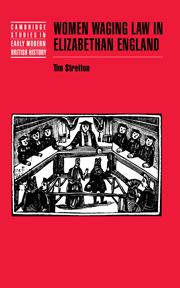Book contents
- Frontmatter
- Contents
- Lists of maps and figures
- List of tables
- Preface
- Notes on the text
- Abbreviations
- 1 Introduction
- 2 Women, legal rights and law courts
- 3 Female litigants and the culture of litigation
- 4 The Court of Requests
- 5 Unmarried women and widows
- 6 Married women in Requests
- 7 Freebench, custom and equity
- 8 Pleading strategies in Requests
- 9 Women waging law
- Glossary
- Bibliography
- Index
- Cambridge Studies in Early Modern British History
Preface
Published online by Cambridge University Press: 11 November 2009
- Frontmatter
- Contents
- Lists of maps and figures
- List of tables
- Preface
- Notes on the text
- Abbreviations
- 1 Introduction
- 2 Women, legal rights and law courts
- 3 Female litigants and the culture of litigation
- 4 The Court of Requests
- 5 Unmarried women and widows
- 6 Married women in Requests
- 7 Freebench, custom and equity
- 8 Pleading strategies in Requests
- 9 Women waging law
- Glossary
- Bibliography
- Index
- Cambridge Studies in Early Modern British History
Summary
In Tudor England, ‘to wage law’ had a technical meaning akin to ‘compurgation’, a process that allowed defendants to defend certain legal actions on oath, supported by the oaths of neighbours or professional oath-takers. In popular use, however, ‘to wage law’ meant simply to go to law, and it is women ‘waging law’ in this more general sense who are the focus of this book.
During the reigns of Elizabeth I and James I, levels of civil litigation rose to unprecedented levels, directly or indirectly touching the lives of the majority of the population. Historians are familiar with the legal exploits of a select band of women at this time, including Anne Clifford, Bess of Hardwick and Lady Elizabeth Russell, but we know little about the legal experiences of the majority of women. What follows is a preliminary attempt to fill this gap through an analysis of women, law and litigation (as opposed to women involved in criminal prosecutions) focused around the sizeable number of women who put their names to lawsuits in the second half of the sixteenth century. It considers laws and the application of laws, estimates levels of female participation in different courts and assesses the attitudes of various individuals inside and outside the legal system to women who went to court. It also looks closely at the language of legal pleadings, comparing it with the language employed by moral commentators, satirists and playwrights.
- Type
- Chapter
- Information
- Women Waging Law in Elizabethan England , pp. xi - xiiiPublisher: Cambridge University PressPrint publication year: 1998

